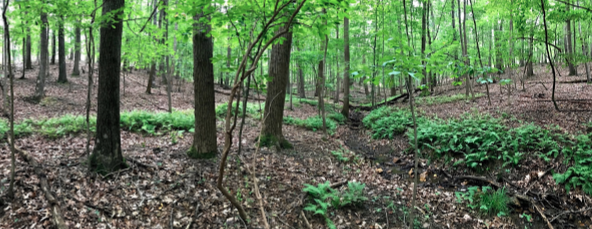Aquatic Ecology: Introduction To Series
As we go about our daily lives we sometimes glimpse streams in our urban or rural landscapes. We might imagine the fish, frogs, insects and turtles who live there, but there is so much more! If you’ve seen their hidden wonders up close, it becomes apparent that these aquatic ecosystems are maybe no less rich and wondrous than, say, a mature forest. In fact, stream ecosystems are full of all manner of really interesting critters and some pretty cool ecology. Do you know that sampling the diversity of an insect community in one part of a stream can tell us about the water quality and health of the stream?
This series of nature blogs will focus on stream ecosystems, critters and the many connections between our landscapes and their “waterscapes”. Mostly we will be exploring small headwater streams, which flow all around our neighborhoods (even if you can’t see them.) We’ll see why their small size belies their importance to aquatic life and stream health. We’ll look at the “Urban Stream Syndrome”, which afflicts many of our streams, as well as “Nature Based Solutions” to stormwater problems and how these can create more aquatic habitat patches in the urban landscape. One of the blogs will be about the “Wheel of Misfortune” in which we will cover the old and new assaults on urban stream critters. Later, we will get into macroinvertebrates.org, which is a super website for meeting aquatic insects up close and personal.
Stream Critter “Personality”
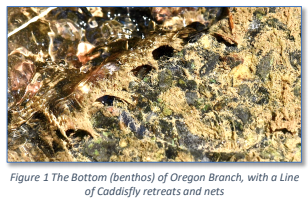
Here is a little bit about one of my favorite groups, the “net-spinning” Caddisflies. Like spiders, caddisfly larvae spin silk to build retreats and nets (like fishing nets) to catch their food in the stream current. Civil Engineers know Hydraulics, and so do these busy insects. Figure 1 shows the benthos (bottom) with retreats and nets lined up like Baltimore rowhomes. Their construction calls for expert knowledge of the movement of water around objects on the bottom. Their structures are positioned at just the right depth, location and angle so that the current and its food is funneled into their nets.
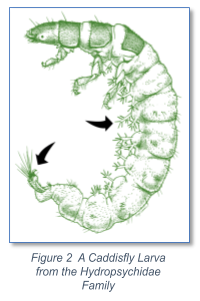
Since they build in fast waters, they have to be like persistent, busy beavers. Storms bring really fast water, especially in urban watersheds, so they may have to rebuild frequently. When I returned to the site in Fig. 1, these nets were gone. Stream currents can be like nasty wind storms that destroy their houses and move stones!
The caddisfly larva in Fig. 2 is from the Hydropsychidae family, one of the “net-spinning” Caddisfly families. They breathe with the branched gills you see in the drawing (they need dissolved oxygen from the water.) Also, since they live in swift currents, they use the claws you see at the end of their tail to anchor them in their retreats and to avoid being swept away by the current. You can see their “C” shaped retreats almost anywhere there is enough current; I even find them on concrete channels and spillways in culverts. For many reasons some Caddisflies are called “Ecosystem Engineers”, e.g., their silk can keep stream channel gravel from being swept away in storms. Like good engineers, they use carefully selected construction materials. Their silk is both super strong, and is flexible (these qualities are also important when civil engineers design bridges and buildings.)
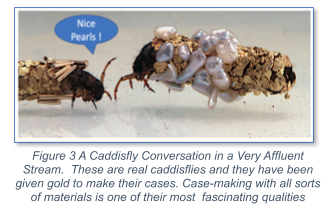
These Hydropsychidae Caddisflies are tough and can resist moderate levels of pollution, so they are quite common in urban streams. They could be the “neighbors” you have not met (yet)! We’ll hear more about their abilities and behaviors in future Blogs. For me, they have lots of personality; I’ve heard that they have real conversations out there on the benthos when we aren’t looking (Fig. 3). We’ll see a lot more personalities in future blogs!
Watershed and Aquatic Critters
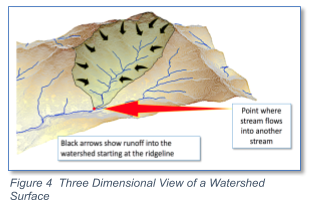
The watershed defines an area that all stream biota are intimately connected to. Many of us are getting to know our watersheds. Telephone surveys have asked people “do you live in a watershed?” It is kind of a trick question, since everyone lives in a watershed, it is just a matter of where you stand in the stream (or pipe.) Here, the point is that what a watershed has on its surface (e.g., trash, oil, etc.) and in its groundwater (e.g., deicers and other pollutants) matters a lot to aquatic creatures in the streams! Usually we see watersheds as lines drawn on a map, but they are three dimensional. It is like an odd shaped, tilted basin in the landscape. Raindrops falling within the basin’s edges become runoff, flowing downhill into streams. The main stream then flows to a downstream point at the bottom of the watershed (see Fig. 4).
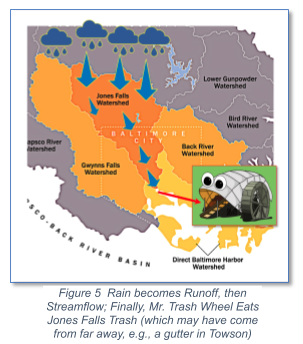
An example of an urban watershed is the Jones Falls, a 56 sq. mile watershed (the orange watershed in Fig. 5) that extends from Owings Mills to the Baltimore Harbor, where Mr. Trash Wheel is located. This example also reminds us that aquatic communities experience what I call a “dark rain” of pollutants brought into their habitats by storm runoff. For example, Mr. Trash Wheel eats trash that comes from all over the Jones Falls watershed! In fact, in February of 2018 the bug-eyed contraption “ate” 145,000 cigarette butts.
Trash- Just an Indicator of an “Urban Stream Syndrome”
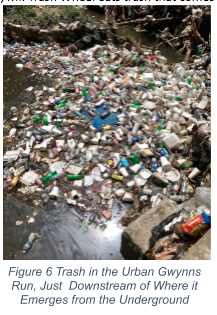
There is a famous paper that coined the term “Urban Stream Syndrome” to talk about the many impacts on urban streams and their biota. Trash is one of those impacts that we can easily see. It is a real eyesore and an emotional downer for folks who love streams. It deprives us of seeing the City’s beautiful stream valleys the way they should be seen. Sadly, trash is just one of thousands of pollutants in the “dark rain” of stormwater runoff that aquatic critters have to endure, especially in urban streams. Since urban watersheds are paved-over with concrete and asphalt, gutters and storm drains are designed to carry runoff to streams very quickly, which is why our streams often look pretty “beat-up” and trashy. The unsightly Gwynns Run in Carroll Park in Baltimore City is a buried urban stream that produces torrents of trash-laden runoff from thousands of gutters (Fig. 6). However it is not just trash; the water is very polluted with runoff from streets, sewage leaks and sediment.
This polluted urban runoff is a real toxic stew (oil, heat, metals, toxins, pharmaceuticals, feces, pathogens, etc.) and quite devastating for the plants, animals and microbes in streams. Even trash has become a threat to ecosystems because plastics never go away, they just keep breaking into tiny and microscopic pieces that are ingested by aquatic biota. Lots of research is now focused on microplastics and nanoplastics and how they enter food webs, potentially affecting bigger critters that eat the little critters that eat the tiny critters.
Loss of Biodiversity and Ecosystem Services
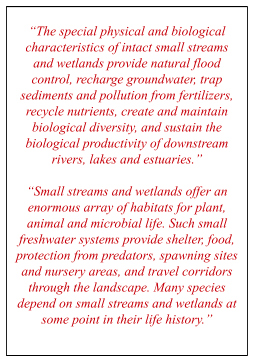
It is a surprise to many that small headwater streams are important ecological hotspots in a way that larger streams and rivers are not. They are indeed beautiful (Fig. 7, Left), but there is a lot going on that you can’t see. They are important ecosystems that integrate above ground flows and wetlands with groundwater and downstream flows, creating an oasis for life. These are biodiversity hotspots and the source of many “Ecological Services.” Just a few of these are shown in the box to the left. These excerpts are from a report sponsored by American Rivers and the Sierra Club in 2003, Where Rivers are Born: The Scientific Imperative for Defending Small Streams and Wetlands (Fig. 7, Right.) It made the point that the health and productivity of rivers and lakes depend upon functional small streams and wetlands. Unfortunately, This report is still very relevant because of continued assaults on small headwater streams and wetlands. Famous river scientist Ellen Wohl wrote in her 2017 review on the subject:
“…you would not expect a forest to remain healthy if you removed all of the leaves from every tree. So we cannot expect our freshwater resources to remain vital if we destroy much of the functioning of headwater streams.”
We are still defending these gems today, even though we know how important they are; they still lack the appreciation and legal protections they need.
Ecosystems within Ecosystems
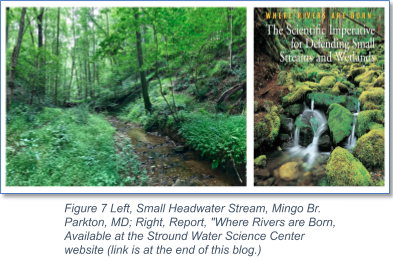
One of the topics we will cover in future blogs is the aquatic ecosystem few have heard-of. The hyporheos (or the hyporheic zone) is absolutely amazing. It sits between two distinct but connected worlds, the stream channel above it and shallow groundwater below it (Fig. 8, Left). Hyporheic flows move slower than stream flows but faster than nearby groundwater flows. They weave through the stream system in the same general direction as the streamflow. The hyporheic zone has a diverse fauna that live there, but it is also used by lots of fauna as temporary quarters. Some insect larvae live there to avoid being eaten but many use this porous media for the young insects (instars) to shelter until they grow to be large enough for the flowing stream world. Many are adapted to this environment, like the Mayfly larva in Fig. 8 (Right), that is able to cause currents in its burrow to bring-in fresh oxygenated water and food.
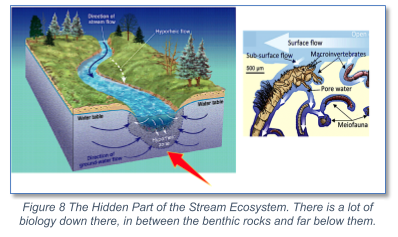
The hyporheos can also extend to the sides of a stream or river, e.g., those piles of sand and stone on the inside of meander bends (center of diagram in the Left side of Fig. 8). I can remember visiting the Flathead Lake Biological Field Station where riverine biologist Jack Stanford showed a group of us the wells that were dug into the river’s hyporheos. It was a real surprise when the well cap was removed; adult stoneflies poured out of the well and flew away. This was ca. a quarter mile away from the river itself! The stoneflies had spent a large portion of their life cycle away from the river, in the hyporheos.
So for streams, there really is more than meets the eye. The hyporheos is only one of many unseen parts of a stream that contribute to its biological functions!
Stream Burial and Zombies
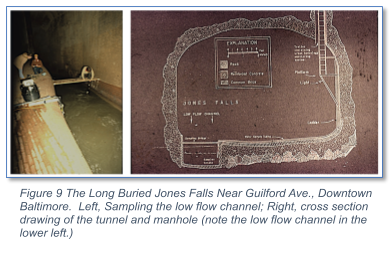
Stream burial is done for a variety of reasons, e.g. due to soil erosion in forestry or agricultural operations or mountaintop mining operations that dump excavated soil and rock into the streams. We are often familiar with the larger buried streams, like the Jones Falls downtown (Fig 9). However small buried streams are unnamed and anonymous. Also, long drainage culverts for highways and roads not only “turn the lights out” but interfere with aquatic organism passage up and downstream (many fish are not Olympic jumpers like salmon!).
Small headwater stream burial is huge problem across urban watersheds. As cities have grown these have often been buried, either because of the high value of land to build on or because the streams were polluted, unsightly and odorous. Even larger streams have been buried, e.g., the Jones Falls in downtown Baltimore flows for over two miles of tunnel (Fig. 10). Baltimore City DPW and USGS sampled this tunnel in the 1980s. We never saw any aquatic life. The worst part was the prevalent odor of sewage and bad air (and then there were the rats.) Jones Falls was originally buried to coverup the stench, for there were many privies that overflowed and lots and lots of horses.. in those days storms brought floods and stench!
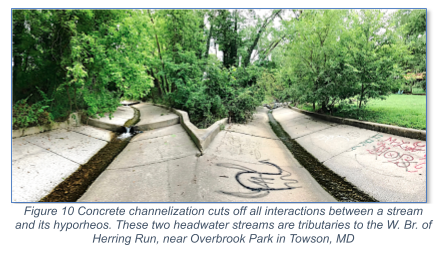
Many streams have been reduced to concrete gutters (Fig. 10), cutting off the hyporheic ecosystem from the stream completely, creating a biological “zombie.” Urban streams became gutters, existing only to move storm flows downstream even faster.
Unfortunately there is little awareness that these small streams are an important part of our river and wetland networks. Often they don’t have the legal protections needed to conserve these ecosystems.
The Many Losses of Stream Burial
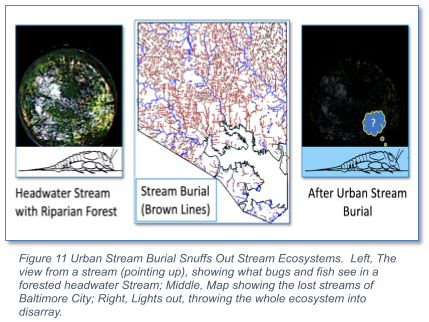
The lifelessness of the tunneled Jones Falls is due to many things, such as leaking sewage and the surges of storm runoff from hard surfaces like rooftops and the concrete and asphalt that buries soil and its ability to absorb the fallen rain. In large part however it is due to the burial of its headwaters and the ensuing loss in biodiversity and ecosystem services that we saw above. In a healthy headwater stream what critters in the benthos “see” are trees and riparian vegetation (Fig. 11, left). These provide shade that lowers stream temperatures and falling leaves and branches provide major sources of food and habitat that aquatic life needs to thrive. Stream life also needs to interact extensively with terrestrial vegetation and biota. For example aquatic insects emerge into the air, becoming prey for spiders, insects and bats. Burying streams cuts off all of those aquatic-terrestrial-groundwater connections. For example, emerging aquatic insects have to fly (not swim!) upstream and shelter in riparian vegetation to lay their eggs and replenish their populations upstream. Maybe this is what is puzzling our little Mayfly in Fig. 11 (left and right), who is wondering what turned the lights out?
We’ve talked about only a modicum of the ecosystem services that are lost when streams are channelized and buried. However, just as threatening is the sheer number of small headwater streams that are buried within storm drain pipes and tunnels. Baltimore City is a prime example. In Fig. 11 (Middle) the streams we know well are in blue (Gwynns Falls, Jones Falls, Herring Run.) The brown lines are the larger storm drains (36” diameter and larger.) A great many of these pipes contain streams that have existed since colonial times. Today monitoring has revealed that the majority of these have continuous dry weather flows, many of these are likely the remnants of streams that flowed in colonial times.
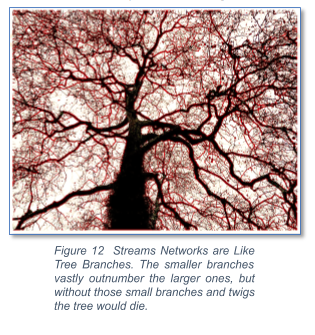
Small streams are like the twigs and small branches of a tree; these make up most of the tree (Fig. 12). Most of this is plumbing designed to move nutrients and water between the roots and the leaves. Remembering Ellen Wohl, we have not simply turned the lights out in our urban headwater streams (Fig. 11, Right), we’ve cut through crucial pipelines. We have lost these hot spots of biodiversity and ecosystem services. This is an awesome number of hotspots to lose. The implications for both terrestrial ecosystems and aquatic downstream ecosystems are huge.
So when you see one of these small useless looking “ditches” or trashy little streams, remember the twigs and leaves of the tree!
What Aquatic Critters “Feel”
“Watershed” is a common hydrology term that is a time-tested concept for flood and pollutant studies. However, I’d like to propose a word that reminds me that aquatic critters live in a unique ecosystem which is largely hidden from our eyes- the “Waterscape.” We see runoff and flooding in our landscape, but the critters who live in the stream ecosystem “feel” only what is carried by the water from upstream and from groundwater entering the hyporheos. I’ll use this term throughout future blogs as a way of focusing on the biology and how it is sustained by water.
Now for a little imagination. If you look at the photograph in Fig. 13, you can see the undulations in the forest land surface and imagine how water makes its way downhill to the low spots and to the stream itself. Try to Imagine the things you cannot see:
- Rainwater soaking into the soil or running down the hills
- Tree roots pumping groundwater up to the leaves
- Massive Tree root networks connecting groundwater and stream water
- A cool stream, shaded by the tree canopy and streamside plants
- Predators and prey crossing the terrestrial- aquatic divides
- Leaves falling into the stream, giving aquatic critters food and habitat
- Plants, Fungi and Microbes cleaning & redistributing water and nutrients
You have just imagined yourself a very connected, fascinating ecosystem! Are you starting to see the waterscape of the aquatic insects ?
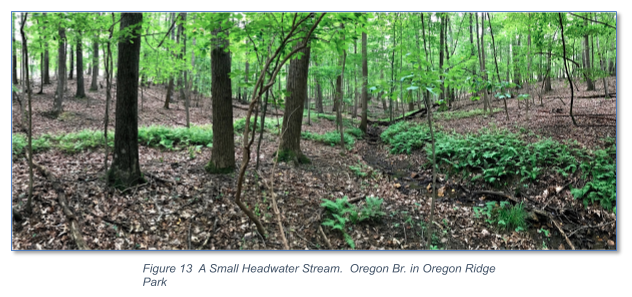
Cool Reading
Judy Meyer et al. 2003 Stroud Water Science Center, Where Rivers are Born..
https://stroudcenter.org/wp-content/uploads/2016/12/lk_meyer2003_defending_streams.pdf
Credits:
Fig. 1 Photo by KTB
Fig. 2 Figure from macroinvertebrates.org, illustrated by Morgan Summerlin, graphics & enhancements by KTB.
Fig. 3 Artist Hubert Duprat (https://www.thisiscolossal.com/2014/07/hubert-duprat-caddisflies/); graphics added by KTB;
Fig. 4. Base graphic by unknown; added graphics, enhancements by KTB
Fig. 5 Base map by Biohabitats, Balt. MD; added graphics, enhancements by KTB
Fig. 6 Photo by KTB
Fig. 7. Stroud Water Science Center website
Fig. 8. Left graphic, USGS; Right graphic from Peralta-Maraver et al. 2018; cropping, enhancements by KTB
Fig. 9. Photo by KTB
Fig. 10. Photo by KTB; drawing, USGS
Fig. 11. Hemispherical photo by KTB; Map by Balt. City DPW; Mayfly graphic from A M Stuart, 1958 Journal of Experimental Biology 35(1) 27-38; cropping, enhancements by KTB
Fig. 12 Water Tree Silhouette photo by Anthony Robinson; edited by KTB
Fig. 13 Photo by KTB

